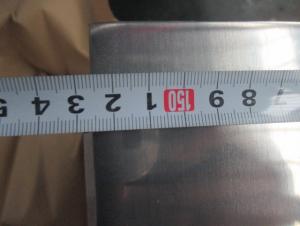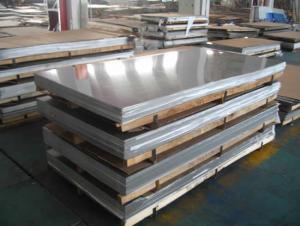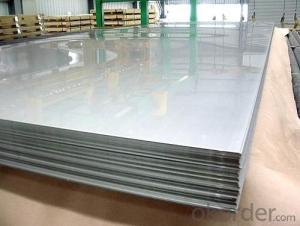Stainless Steel Sheet With Best Price In Warehouse
- Loading Port:
- Shanghai
- Payment Terms:
- TT or LC
- Min Order Qty:
- 3 m.t.
- Supply Capability:
- 2000 m.t./month
OKorder Service Pledge
OKorder Financial Service
You Might Also Like
1、Structure of 304/2B STAINLESS STEEL SHEET.
STAINLESS STEEL SHEET IS ONE POPULAR PRODUCTS IN CHINA MARKET, IT HAVE SEVERAL DIFFERENT APPLICATIONS, SUCH AS, CONSTRUCTION, BUILDING, DECORATION, ETC.
THE GRADE ALSO INCLUDE: 200 SERIES, 300 SERIES, 400 SERIES, ETC.
Mainly applied in the industry of furniture, sports equipment, compressed containers, shipbuilding, railway and the automotive.
2、Main Features of the 304 STAINLES STEEL SHEET.
High intensity
Low welding costs.
Outstanding color compatibility after anodizing
Easy to operate. All-position welding.
Excellent corrosion resistance
Wide applicability.
Length per spool only for reference


WIDTH*LENGTH: 1219MM*2438MM, 1500MM*3000MM, 1500MM*6000MM,ETC.
THE THICKNESS IS NORMALLY FROM 0.1MM TO 3MM, THEY ARE THE COLD ROLLED SHEET.
5、FAQ of 304/2B STAINLESS STEEL SHEET.
a.What is monthly capacity
---CNBM is one stated own company and our monthly capacity is about 2000tons.
b. Now which countries do you export your goods?
----Now we export to South East Asia,USA, UAE, SRI LANKA, BANGLADESH, Africa, North America,South America ect.
- Q: Can stainless steel sheets be used for elevator floors?
- Yes, stainless steel sheets can be used for elevator floors. Stainless steel is a durable and corrosion-resistant material that is commonly used in various applications, including elevator interiors. Stainless steel sheets provide a sleek and modern look to elevator floors while also offering excellent resistance against wear and tear, stains, and impact. Additionally, stainless steel is easy to clean and maintain, making it a practical choice for elevator floors that experience heavy foot traffic.
- Q: Can stainless steel sheets be used for wire mesh?
- Certainly, wire mesh can be made from stainless steel sheets. Stainless steel, being a highly versatile material, finds extensive usage across numerous applications owing to its exceptional durability, resistance to corrosion, and strength. Once stainless steel sheets undergo processing to transform into wire mesh, they acquire a robust and dependable mesh structure. Industries like construction, agriculture, mining, and filtration often employ stainless steel wire mesh due to its remarkable ability to endure harsh environments, withstand rust and corrosion, and uphold its structural integrity throughout time.
- Q: Are stainless steel sheets suitable for power plant equipment?
- Yes, stainless steel sheets are highly suitable for power plant equipment. Stainless steel is known for its exceptional corrosion resistance, high strength, and durability, making it an ideal material for various applications in power plants. It can withstand high temperatures, pressure, and chemical exposure commonly found in power generation environments. Additionally, stainless steel's hygienic properties, ease of maintenance, and long lifespan make it a preferred choice for power plant equipment.
- Q: Can stainless steel sheets be used for HVAC systems?
- Yes, stainless steel sheets can be used for HVAC systems. Stainless steel is highly resistant to corrosion and can withstand high temperatures, making it an ideal material for HVAC components such as ductwork, heat exchangers, and exhaust systems. It is also durable and easy to clean, ensuring long-lasting performance in HVAC applications.
- Q: Can stainless steel sheets be used for medical implants or devices?
- Yes, stainless steel sheets can be used for medical implants or devices. Stainless steel is a commonly used material in the medical field due to its high strength, corrosion resistance, and biocompatibility. It is particularly suitable for applications such as surgical instruments, orthopedic implants, and dental tools, where durability and hygiene are essential.
- Q: What is the thickness range for stainless steel sheets?
- The thickness range for stainless steel sheets can vary, but it typically falls between 0.4mm to 6mm.
- Q: Are stainless steel sheets suitable for marine environments?
- Yes, stainless steel sheets are suitable for marine environments. Stainless steel is highly resistant to corrosion and rust due to the presence of chromium in its composition. This makes it an ideal material for use in marine environments where constant exposure to saltwater and moisture can cause other metals to corrode quickly. Stainless steel sheets also have good mechanical properties, high strength, and excellent durability, which further make them suitable for marine applications. Additionally, stainless steel is easy to clean and maintain, ensuring its longevity and performance in harsh marine conditions.
- Q: What is the minimum thickness of stainless steel sheets available?
- The minimum thickness of stainless steel sheets available typically starts at around 0.4 millimeters.
- Q: Can stainless steel sheets be cut or shaped?
- Yes, stainless steel sheets can be cut or shaped to meet specific requirements. Stainless steel is a versatile material that can be easily manipulated using different cutting and shaping techniques. Cutting stainless steel sheets can be done using methods such as shearing, laser cutting, or waterjet cutting. Shaping stainless steel sheets can be achieved through processes like bending, rolling, or stamping. These techniques allow for the creation of various forms and designs, making stainless steel sheets a popular choice in industries such as construction, automotive, and manufacturing.
- Q: What are the different types of mirror finishes available for stainless steel sheets?
- There are several different types of mirror finishes available for stainless steel sheets, each offering a unique appearance and level of reflectivity. 1. #8 Mirror Finish: This is the most reflective and commonly used mirror finish. It has a highly polished surface with a mirror-like appearance, providing excellent reflectivity and clarity. This finish is achieved by using progressively finer grit abrasive compounds during the polishing process. 2. #7 Mirror Finish: This finish is slightly less reflective than the #8 mirror finish but still offers a high level of reflectivity. It has a smooth, shiny surface with minimal distortion, making it suitable for applications where a high level of reflectivity is desired. 3. #6 Mirror Finish: This finish has a moderately reflective surface with a slightly duller appearance compared to the #7 and #8 mirror finishes. It provides good reflectivity while hiding minor surface imperfections. It is often used in architectural applications where a balance between reflectivity and durability is required. 4. Satin Mirror Finish: This finish has a satin-like appearance with a low level of reflectivity. It has a smooth surface with a brushed texture, providing a subtle and sophisticated look. It is commonly used in decorative applications such as interior design or furniture. 5. Antique Mirror Finish: This finish is achieved by applying special chemical treatments to the stainless steel surface, creating a vintage or aged appearance. It has a reflective surface with a distorted and tarnished look, adding a unique and artistic touch to various applications. Overall, the choice of mirror finish depends on the desired level of reflectivity, aesthetic preferences, and specific application requirements.
Send your message to us
Stainless Steel Sheet With Best Price In Warehouse
- Loading Port:
- Shanghai
- Payment Terms:
- TT or LC
- Min Order Qty:
- 3 m.t.
- Supply Capability:
- 2000 m.t./month
OKorder Service Pledge
OKorder Financial Service
Similar products
Hot products
Hot Searches
Related keywords




























